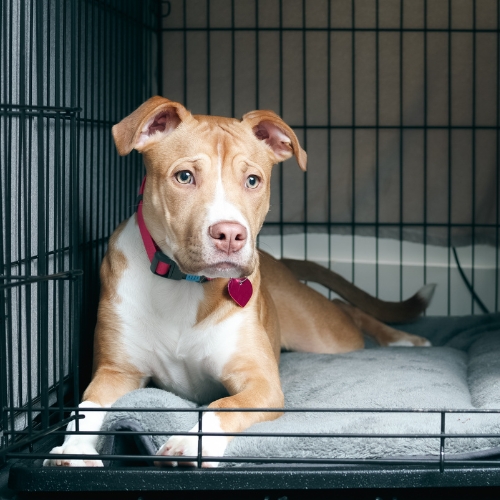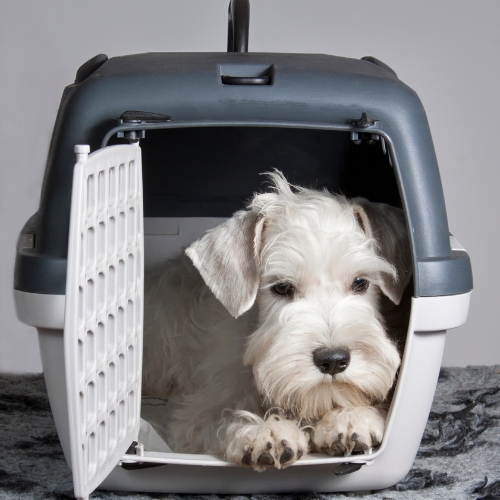Start by placing the dog crate in a room with the door of the crate secured open. It’s best to do this with your dog out of the room so that the dog doesn’t get startled by any noises coming from the crate as you build it up. Make sure that the crate will not be in direct sunlight – remember that the sun will move round and may eventually shine on the crate. Place your dog’s bed or familiar bedding inside the crate to make it more appealing and comfortable for them.

Bring your dog into the room, allowing them to investigate on their own terms. Each time the dog shows any interest in the crate reward them with a treat – even if it’s just a wee sniff in the direction of the crate – it’s a start! If the dog goes inside the crate, reward them with several treats but do not shut them in yet as this may worry them. Make sure that the crate door is still secured open as we don’t want the door swinging shut accidentally and alarming the dog. Now that the dog has been introduced to the crate, make the crate more appealing by placing treats and toys inside and feeding them their meals in there.
Once you feel that your dog is settled, happy and showing no signs of anxiety inside the open crate, gently close the door but do not lock it. Repeat this for several days, ensuring they remain relaxed throughout. It’s a great idea to provide a longer lasting chew or a stuffed Kong or food toy inside the crate. This way the dog will take longer to finish the chew/food/treats. It’s always a good idea to cover the crate in a blanket or sheet so that all sides are covered apart from the side with the door in.
When your dog is really relaxed and using the crate happily, you can begin to lock the door for short periods of time while you are still in the room. Gradually build up to locking the door and leaving the room for short periods of time, and then eventually the house.
Remember that your dog should always have access to water – you can get special bowls for metal crates that hook onto the side or non-spill water bowls that work well in fabric crates.
If you are struggling to have your dog stay in the crate for any length of time/the dog lifts the food stuffed toy out the crate – try lacing strong string through the Kong and tying it into the crate so your dog cannot remove it and has to stay in the crate to eat whatever is stuffed in their Kong!
Similarly, if your dog will not (after a reasonable length of time trying) go into the crate, try securing the toy in the crate as described above, having filled it with something MEGA tasty and smelly and shut the crate door with the dog on the outside of the crate! The dog will hopefully be really frustrated that they cannot gain access to the smelly food toy. Presuming this is the case, let the dog be frustrated for a few mins (but not long enough that they loose interest) and then open the crate door and let them into the food stuffed toy!


Meet Mary – our certified behaviourist
Our dog behaviour service is led by Mary Howat, who many of you may recognise from our Blairgowrie team!
Mary started working with Thrums in 2003, and has progressed to qualify as a Certified Canine Behaviourist and Certified Elite Fear Free Trainer. She also runs her own dog behaviour and training consultancy, K9INTUITION, taking veterinary referrals, behaviour consultations, one to one sessions with puppies and their owners and also providing advice for clients on choosing a puppy and before they have brought their puppy home.
She shares her life and home with her husband, their cat Harray and their new friend – Moose the chocolate Labrador.
Call our Kirriemuir team today to book an appointment on 01575 572 643.
